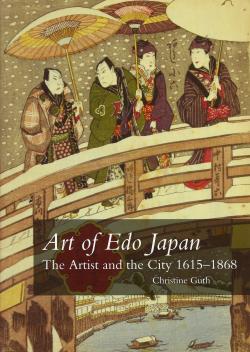Art of Edo Japan, The Artist and the City 1615-1868

Review by Sir Hugh Cortazzi
This book was first published in hard back in 1996. It is a useful and readable introduction to the painters and print artists of this prolific period in Japanese art. It does not cover, except very cursorily, other aspects of Japanese art in the Edo era. Nor does it directly describe the political, economic or social life or the prolific literature of the age. But anyone who wants a reasonably priced survey of painters and print artists in Edo Japan will find this a useful and reasonable purchase.
Christine Guth declares rather ponderously that “This book takes as its premise that a strong sense of urban and regional identity is one of the distinguishing features of Edo-period culture. It surveys the activities of selected artists in their physical and socio-economic environments to bring into relief the cultural dynamics within and among four major cities, Kyoto, Edo, Osaka and Nagasaki.” Thus after an introduction on “Mapping the Artistic Landscape” the author devotes separate chapters to Kyoto artists, Edo artists, Osaka and Nagasaki artists with a final chapter devoted to itinerant, provincial and rural artists. The chapter on Kyoto artists gives a useful summary of the development of the Kano and Tosa schools of painting and such famous individual painters as Kōrin, Kōetsu, Sōtatsu and Jakuchū. The chapter on Edo artists concentrates on print artists. The chapter on Nagasaki reminds readers of the influence of Dutch studies (rangaku) and the importance of artists such as Shiba Kōkan.
Most of the illustrations will be familiar to students of Japanese art, but I was not familiar with some such as this one by Maruyama Ōkyo (1733-95), in the Nagasaki Prefectural Art Museum, of “The Riverside At Shijō,” a nocturnal scene, designed for viewing in a stereoscopic device, where figures are silhouetted against lantern-lit restaurants and theatres while an acrobatic performance dominates the background (see below).
And this, a print by Shunkōsai Hokuei (d.1836) depicting a dramatic scene where Lady Osuma emerges from the cave where she has been hiding and shines a torch on Hanbei, her brother-in-law’s murderer (Victoria and Albert Museum (below).

